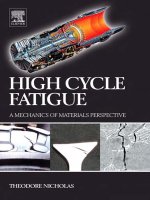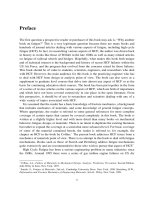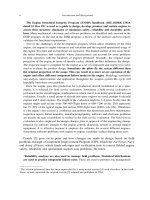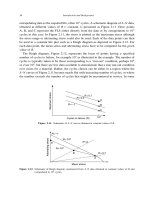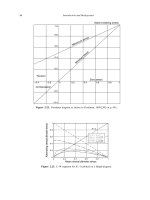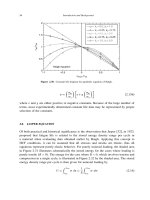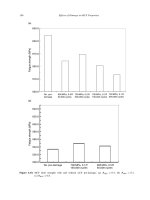Mechanics of Materials 1 Part 6 pps
Bạn đang xem bản rút gọn của tài liệu. Xem và tải ngay bản đầy đủ của tài liệu tại đây (2.1 MB, 70 trang )
$1
3.6
Complex Stresses
333
I
I
01
1
v
I
c
I
Fig.
13.9.
Mohr’s
stress
circle.
Join
AB
and
z.
The point
P
where this line cuts the
a
axis is then the centre of Mohr’s
line is the diameter; therefore the circle can now
be
drawn.
circle,
and the
Every point on the circumference of the circle then represents a state of stress on some plane
through
C.
Proof
Consider any point
Q
on the circumference of the circle, such that
PQ
makes an angle 28
with
E,
and drop a perpendicular from
Q
to
meet the
a
axis at
N.
Coordinates
of
Q:
ON
=
OP+PN
=
~(0,+a,)+R~0~(28-fl)
=
$(ax
+
a,)
+
R
cos 28 cos
p
+
R sin 28 sin
p
But R cos
p
=
+(a,
-
a,)
and
R
sin
p
=
T,~
On
inspection this
is
seen
to
be eqn.
(13.8)
for the direct stress
BC
in Fig. 13.5.
ON
=
+(ax
+
a,) ++(a,
-
a,)cos 28
+
T,,
sin
28
on the plane inclined at
8
to
Similarly,
QN
=
R
sin (28
-
p)
=
Rsin28cos~-Rcos28sin~
=
+(ax
-
a,)
sin 28
-
T,~
cos 28
Again, on inspection this is seen
to
be eqn. (13.9) for the shear stress
TO
on the plane inclined at
t)
to
BC.
334
Mechanics
of
Materials
613.7
Thus the coordinates
of
Q
are the normal and shear stresses on
a
plane inclined at
8
to
BC
in the original stress system.
N.B Single angle
ZPQ
is
28
on Mohr’s circle and not
8,
it is evident that
angles are
doubled on Mohr’s circle.
This is the only difference, however, as they are measured in the
same direction and from the same plane in both figures (in this case counterclockwise from
BC
).
-
Further points to note are:
(1)
The direct stress is a maximum when
Q
is at
M,
i.e.
OM
is the length representing the
maximum principal stress
a1
and
28,
gives the angle of the plane
8,
from
BC.
Similarly,
OL
is the other principal stress.
(2)
The maximum shear stress is given by the highest point on the circle and is represented
by the radius of the circle. This follows since shear stresses and complementary shear
stresses have the same value;
therefore the centre
of
the circle will always lie on the
a
axis
midway between
a,
and
a,.
(3)
From the above point the direct stress on the plane of maximum shear must
be
midway
between
a,
and
a,,,
i.e.
$(a,
+
a,).
(4)
The shear stress on the principal planes is zero.
(5)
Since the resultant of two stresses at
90”
can
be
found from the parallelogram of vectors
as the diagonal, as shown in Fig.
13.10,
the resultant stress on the plane at
8
to
BC
is
given by
OQ
on Mohr’s circle.
Fig.
13.10.
Resultant stress
(8,)
on
any
plane.
The graphical method of solution of complex stress problems using Mohr’s circle is
a
very
powerful technique since all the information relating to any plane within the stressed element
is
contained in the single construction. It thus provides
a
convenient and rapid means of
solution which is less prone to arithmetical errors and is highly recommended.
With the growing availability and power of programmable calculators and microcom-
puters it may be that the practical use of Mohr’s circle for the analytical determination
of
stress (and strain-see Chapter
14)
values will become limited. It will remain, however, a
highly effective medium for the teaching and understanding of complex stress systems.
A
free-hand sketch
of
the Mohr circle construction, for example, provides a convenient
mechanism for the derivation (by simple geometric relationships) of the principal stress
equations
(13.1 1)
or
of
the equations for the shear and normal stresses on any inclined plane
in terms
of
the principal stresses as shown in Fig.
13.11.
13.7.
Alternative representations
of
stress distributions at a point
The way in which the stress at a point vanes with the angle at which a plane is taken through
the point may be better understood with the aid of the following alternative graphical
representations.
$13.7
Complex
Stresses
tt
335
'6
Fig.
13.11.
Free-hand
sketch
of
Mohr's
stress
circle.
Equations
(13.8)
and
(13.9)
give the values of the direct stress
ug
and shear stress
re
on any
plane inclined at an angle
8
to the plane on which the direct stress
u,
acts within a two-
dimensional complex stress system, viz:
ug
=
*(a,
+
a,)
+3(ux
-
0,)
cos
28
+
s,,
sin
28
q,
=
i(u,
-
cy)
sin
28
-
T~~
cos
28
(a)
Uniaxial
stresses
For the special case of a single uniaxial stress
ux
as in simple tension or on the surface of a
beam in bending,
u,
=
zxy
=
0
and the equations
(13.8)
and
(13.9)
reduce to
00
=
$0,
(1
+
COS
28)
=
6,
COS'
8.
N.B.
If the single stress were selected as
u,
then the relationship would have reduced
to
that of
eqn.
(13.1),
i.e.
ae
=
uy
sin'
8.
Similarly:
70
=
3
ox
sin
28.
Plotting these equations on simple Cartesian axes produces the stress distribution diagrams
of Fig.
13.12,
both sinusoidal in shape with shear stress "shifted by
45"
from the normal
stress.
Principal stresses
op
and
oq
occur, as expected, at
90"
intervals and the amplitude
of
the
normal stress curve is given by the difference between the principal stress values. It should
also be noted that shear stress is proportional to the derivative of the normal stress with
respect to
8,
i.e.
70
is a maximum where doe/d8 is a maximum and
70
is zero where
da,/d8
is
zero, etc.
Alternatively, plotting the same equations on polar graph paper, as in Fig.
13.13,
gives an
even more readily understood pictorial representation of the stress distributions showing a
peak
value of direct stress in the direction of application of the applied stress
ox
falling to zero
336
Mechanics
of
Materials
$13.7
re
I
up
=ux
uq
=uy
=o
r,,
:O
1 1 1
I
1
I
I
O0
45"
90"
135'
180"
225'
270"
315'
?
3"8
IX)
(Y)
(X)
(Y)
(X)
(P)
(q)
(P)
(q)
(PI
Fig. 13.12. Cartesian plot
of
stress distribution at a point under uniaxial applied stress.
Y
Direct
(normal)
stress
us
/
X
Shear
stress
ro
Fig.
13.13.
Polar plot
of
stress distribution at a point under uniaxial applied stress.
in directions at right angles and maximum shearing stresses on planes at
45"
with zero shear
on the
x
and
y
(principal) axes.
(b)
Biaxial stresses
In almost all modes of loading on structural members
or
engineering components the
stresses produced are a maximum at the free (outside) surface. This is particularly evident for
$13.7
Complex
Stresses
337
the cases of pure bending or torsion as shown by the stress diagrams of Figs.
4.4
and
8.4,
respectively, but is also true for other more complex combined loading situations with the
major exception of direct bearing loads where maximum stress conditions can be sub-surface.
Additionally, at free surfaces the stress normal to the surface is always zero
so
that the most
severe stress condition often reduces, at worst, to a two-dimensional plane stress system
within the surface
of
the component. It should be evident, therefore that the biaxial stress
system is of considerable importance to practical design considerations.
The Cartesian plot of a typical bi-axial stress state is shown in Fig.
13.14
whilst Fig.
13.15
shows the polar plot of stresses resulting from the bi-axial stress system present on the surface
of a thin cylindrical pressure vessel for which
oP
=
oH
and
oq
=
uL
=
3oH
with
t,,,
=
0.
Fig.
13.14.
Cartesian plot
of
stress distribution at a point under a typical biaxial applied stress
system.
It should be noted that the whole of the information conveyed on these alternative
representations is also available from the relevant Mohr circle which, additionally, is more
amenable to quantitative analysis. They do not, therefore, replace Mohr’s circle but are
included merely to provide alternative pictorial representations which may aid a clearer
understanding of the general problem of stress distribution at a point. The equivalent
diagrams for strain are given in
914.16.
338
Mechanics
of
Materials
Y
t
Direct
lnormol)
stress
u
813.8
Fig.
13.15.
Polar plot
of
stress distribution under typical biaxial applied stress system.
13.8.
Three-dimensional stresses
-
graphical
representation
Figure 13.16 shows the general
three-dimensional
state of stress at any point in a body, i.e.
the body will be subjected to three mutually perpendicular direct stresses and three shear
stresses.
Figure 13.17 shows a
principal element
at the same point, i.e. one in general rotated relative
to the first until the stresses
on
the faces are principal stresses with no associated shear.
Figure 13.18 then represents true views on the various faces of the principal element, and
for each two-dimensional stress condition
so
obtained a Mohr circle may
be
drawn. These
F
QYY
Fig. 13.16. Three-dimensional
stress
system.
$13.8
Complex
Stresses
339
Fig. 13.17. Principal element.
Q3
Q-
(a)
(b)
(C)
Fig. 13.18. True views on the various faces of the principal element
can then
be
combined
to
produce the complete three-dimensional Mohr circle representation
shown in Fig.
13.19.
The largecircle between points
u1
and
o3
represents stresses on all planes through the point
in question containing the
o2
axis. Likewise the small circle between
o2
and
u3
represents
Fig. 13.19. Mohr circle representation of three-dimensional stress state showing the principal circle,
the radius
of
which is equal
to
the greatest shear stress present in the system.
340
Mechanics
of
Materials
$13.8
stresses on all planes containing the
o1
axis and the circle between
o1
and
o2
all planes
containing the
o3
axis.
There are, of course, an infinite number of planes passing through the point which do not
contain any of the three principal axes, but it can be shown that all such planes are repre-
sented by the shaded area between the circles. The procedure involved in the location of a
particular point in the shaded area which corresponds to any given plane is covered in
Mechanics ojMaterials
2.t
In practice, however, it is often the maximum direct and shear
stresses which will govern the elastic failure of materials. These are determined from the
larger of the three circles which is thus termed the
principal circle
(T,,.,~~
=
radius).
It is perhaps evident now that in many two-dimensional cases the maximum (greatest) shear
stress value will be missed by not considering
o3
=
0
and constructing the principal circle.
Consider the stress state shown in Fig. 13.20(a).
If
the principal stresses
ol,
o2
and
o3
all
have non-zero values the system will
be
termed “three-dimensional”; if one of the principal
stresses is zero the system is said to
be
“two-dimensional” and with two principal stresses zero
a “uniaxial” stress condition is obtained. In all
cases,
however, it is necessary to consider all
three principal stress values in the determination of the maximum shear stress since out-of-
plane shear stresses will be dependent on all three values and one will
be
a
maximum
-
see Fig. 13.20(b), (c) and (d).
1”
Fig.
13.20.
Maximum shear
stresses
in
a
three-dimensional
stress
system.
Examples
of
the crucial effect of consideration
of
the third (zero) principal stress value in
apparently “two-dimensional” stress states are given below:
(a) Thin cylinder.
principal stresses:
An element in the surface of a thin cylinder subjected to internal pressurep will have
o1
=
OH
=
pd/2t
o2
=
aL
=
pd/4t
$E.
J.
Hearn,
Mechanics
of
Materials
2, 3rd
edition (Butterworth-Heinemann, Oxford,
1997).
413.8
Complex Stresses
34
1
with the third, radial, stress
o,
assumed to
be
zero-see Fig. 13.21(a).
Fig. 13.21(b) with
a
maximum shear stress:
A
two-dimensional Mohr circle representation of the stresses in the element will give
1
Tmax=T(o1-0~)
I
(b)
3D
Mohr
circles
Fig.
13.21.
Maximum
shear stresses
in
a
pressurised
thin cylinder
A
three-dimensional Mohr circle construction, however, is shown in Fig. 13.21(c), the zero
value of
o3
producing a much larger principal circle and a maximum shear stress:
Tmax=+(ol-uj)=$
0
=-
(E
)
:
i.e.
twice
the value obtained from the two-dimensional circle.
(b)
Sphere
Consider now an element in the surface of a sphere subjected to internal pressure pas shown
in Fig. 13.22(a). Principal stresses on the element will then
be
o1
=
o2
=
-
with
or
=
o3
=
0
pd
4t
normal to the surface.
The two-dimensional Mohr circle is shown in Fig. 13.22(b), in this case reducing to a point
since
o1
and
u2
are equal. The maximum shear stress, which always equals the radius of
Mohr's, circle is thus zero and would seem to imply that, although the material of the vessel
may well
be
ductile and susceptible to shear failure, no shear failure could ensue. However,
342
Mechanics
of
Materials
$13.8
‘t
I
(
b)
2D
Mohr
circle
TI
.
Pd
UH
-
-
4t
I
(
C)
30
Mohr
circles
Fig.
13.22.
Maximum shear stresses in a
pressurised
thin
sphere.
this is far from the truth as will
be
evident when the full three-dimensional representation is
drawn as in Fig. 13.22(c) with the third, zero, principal stress taken into account.
A
maximum shear stress is now produced within the
olo3
plane
of
value:
T,,,
=
3
(01
-
03)
=
pd/8t
The greatest value
of
z
can be obtained
analytically
by using the statement
z
max
=
3
(greatest principal stress
-
least principal stress)
and considering separately the principal stress conditions as illustrated in Fig. 13.18.
Examples
Example
13.1
(A)
A
circular bar
40
mm diameter carries an axial tensile load of 100 kN. What is the value of the
shear stress on the planes on which the normal stress has
a
value of
50
MN/m’ tensile?
So
1
ut
ion
Tensile stress
=
79.6 MN/mZ
F
100
x
103
A
It
x
(0.02)’
=-=
Now
the normal stress on an oblique plane is given by eqn. (13.1):
og
=
o,
sin’
8
50
x
lo6
=
79.6
x
lo6
sin’
6
8
=
52”
28’
Complex
Stresses
343
The shear stress on the oblique plane is then given by eqn. (13.2):
T@
=
ioy
sin 28
=
3
x
79.6
x
lo6
x
sin
104"
56
=
38.6
x
lo6
The required shear
stress
is
38.6
MN/rnZ.
Example
13.2
(AIB)
Under certain loading conditions the stresses in the walls of a cylinder are as follows:
(a) 80 MN/mZ tensile;
(b)
30 MN/mZ tensile at right angles to (a);
(c) shear stresses of 60 MN/m2 on the planes on which the stresses (a) and
(b)
act; the shear
Calculate the principal stresses and the planes on which they act. What would
be
the effect
on these results if owing to a change
of
loading (a) becomes compressive while stresses (b)
and (c) remain unchanged?
couple acting on planes carrying the 30 MN/m' stress is clockwise in effect.
Solution
Fig.
13.23.
The principal stresses are given
by
the formula
c1
and
oz
=$(o,+oy)f)J[(ox-oy)2+47,2y]
=
3
(80
+
30)
=
55
5J(25
+
144)
=
55+65
$J[
(80
-
30)'
+
(4
x
602)]
o1
=
120MN/m2
o2
=
-
10MN/mZ
(i.e. compressive)
and
344
Mechanics
of
Materials
The planes on which these stresses act can
be
determined from eqn.
(13.14),
i.e.
6
-6,
tan
8,
=
P
ZXY
120
-
80
tan
8,
=
____
-
-
0.6667
60
e,
=
330 41'
-
10- 80
60
=
1.50
Also tan
8,
= =
8,
=
-
56" 19 or 123" 41'
N.B The resulting angles are at
90"
to each other as expected.
If the loading is now changed
so
that the
80
MN/m' stress becomes compressive:
6,
=
f
(
-
80+ 30)+*J[
(
-80- 30)'
+
(4
x
60')]
=
-
25
+
5J(
121
+
144)
=
-
25
+
81.5
=
56.5
MN/m2
o2
=
-25-81.5
=
-
106.5MN/m2
and
Then tan8,
=
56.5
-
(
-
80)
=
2.28
60
and
8,
=
66
19
8,
=
66"
19'
+
90
=
156" 19
Mohr's circle
solutions
In the first part
of
the question the stress system and associated Mohr's circle are as drawn
By measurement:
in Fig.
13.24.
o1
=
120MN/m2 tensile
6'
=
10MN/m2 compressive
8,
=
34" counterclockwise from
BC
8,
=
124" counterclockwise from
BC
and
When the
80
MN/m' stress is reversed, the stress system is that in Fig.
13.25,
giving Mohr's
The required values are then:
circle as drawn.
o1
=
56.5MN/m2 tensile
o2
=
106.5 MN/m' compressive
8,
=
66" 15' counterclockwise to
BC
and
8,
=
156" 15' counterclockwise to
BC
Complex Stresses
30
345
=
120
MN/m2
I
u2=-10
MN/rn2
Fig.
13.24.
30
t
II
-80
-40
r-_u2=-106.5
MN/rn2,,
u,
=56.5
MN/rnq
Fig.
13.25
Example
13.3
(B)
A
material
is
subjected to two mutually perpendicular direct stresses
of
80
MN/mZ tensile
and
50
MN/mZ compressive, together with a shear stress
of
30
MN/mZ. The shear couple
acting on planes carrying the
80
MN/m2 stress is clockwise in effect. Calculate
346
Mechanics
of
Materials
the
the
the
magnitude and nature
of
the principal stresses;
magnitude
of
the maximum shear stresses in the plane
of
the given stress system;
direction
of
the planes on which these stresses act.
Confirm your answer by means
of
a Mohr’s stress circle diagram, and from the diagram
determine the magnitude
of
the normal stress on a plane inclined at
20”
counterclockwise to
the plane on which the
50
MN/m’ stress acts.
Solution
80
MN/m2
t
Fig.
13.26.
(a) To find the principal stresses:
u1
and
o2
=
+(ox
+
by)
++&ox
-
o,)*
+
~TZ,,]
=
+(
-
50+80)f+J[(
-
50
-
80)’
+
(4
x
9OO)]
=
5[3
f
J(169
+
36)]
=
5[3
f
14.311
u1
=
86.55
MN/mZ
o2
=
-
56.55
MN/m’
The principal stresses are
86.55 MN/m2 tensile and 56.55 MN/m2 compressive
(b)
To find the maximum shear stress:
01
-
~2
86.55
-
(-
56.55) 143.1
-
-
-
71.6
MN/m2
7max=
~
-
2 2 2
Maximum shear stress
=
71.6MN/m2
(c) To find the directions
of
the principal planes:
0
-6,
86.55-(-50)
30
tan8,
=
=
TXY
136.55
30
=
-
=
4.552
Complex
Stresses
347
e,
=
77036
e2
=
770
36'
+
900
=
1670 36
The principal planes are inclined at
77"
36' to the plane on which the
50
MN/m2 stress acts.
The maximum shear planes are at
45"
to the principal planes.
Mohr's
circle solution
The stress system shown in Fig. 13.26 gives the Mohr's circle in Fig. 13.27.
80
MNh2
Fig.
13.27.
By measurement
c,
=
87MN/mZ tensile
c2
=
57 MN/mZ compressive
T,,,
=
72 MN/m2
and
The direct or normal stress on a plane inclined at 20" counterclockwise to
BC
is obtained
by
c
=
16 MN/mZ compressive
measuring from
This gives
on the Mohr's circle through 2
x
20"
=
40"
in the same direction.
348
Mechanics
of
Materials
Example
13.4
(B)
At a given section a shaft is subjected to a bending stress
of
20 MN/m2 and a shear stress of
40
MN/m2. Determine:
(a) the principal stresses;
(b) the directions
of
the principal planes;
(c) the maximum shear stress and the planes on which this acts;
(d) the tensile stress which, acting alone, would produce the same maximum shear stress;
(e) the shear stress which, acting alone, would produce the same maximum tensile
principal stress.
Solution
(a)
The bending stress is a direct stress and
can
be treated as acting on the
x
axis,
so
that
a,
=
20 MN/m2; since no other direct stresses are given,
a,
=
0.
Principal stress
0,
=
+(a,+a,)+iJ~(~, ,)~
+42:,1
=
3
x
20
+
3J[202
+
(4
x
402)]
=
10+
5J(68)
=
10+ 5
x
8.246
=
51.23MN/mZ
and
a2
=
10-41.23
=
-
31.23 MN/m2
(b) Then
a
-a,
51.23 -20 31.23
-
o.7808
=
40
40
tan8,
=
JL-
=
ZXY
el
=
370
59'
and
-
31.23
-
20
-
51.23
-
1.2808
-
=
40 40
tan8,
=
O2
=
-
52"
1'
or 127"
59'
both angles being measured counterclockwise from the plane on which the 20 MN/m2 stress
acts.
(c) Maximum shear stress
aI
-
0,
2
51.23
-
(-
31.23)
2
Zmax=
~
=
82.46
2
=
__
=
41.23 MN/m2
This acts on planes at 45" to the principal planes,
i.e.
at
82"59'
or
-7"
1'
(d) Maximum shear stress
zmax=
+Jc(~,
-
0,)'
+
4~2~1
Complex
Stresses
349
Thus if a tensile stress is to act alone to give the same maximum shear stress
(6,
=
0
and
maximum shear stress
=
i,/(oz)
=
30,
ZXY
=
0):
41.23
=
$0,
i.e.
ox
=
82.46 MN/m2
The required tensile stress is
82.46
MN/mZ.
(e)
Principal stress
81
=
t(u,+by)+fJ~(ux-by)2+4?zyl
01
=
3J(4?3
=
Txy
Thus if a shear stress is to act alone to give the same principal stress
(0,
=
uY
=
0):
51.23
=
rxY
The required shear stress is
51.23 MN/m2.
Mohr's
circle
solutions
(a),
(b),
(c) The stress system and corresponding Mohr's circle are as shown in Fig.
13.28.
By measurement:
(a)
u1
N
51 MN/m2
tensile
u2
'v
31 MN/m2
compressive
76"
(b)
8,
=
-
=
380
2
82
=
38"
+
90"
=
128"
(c)
rrnaX=
41 MN/m2
Fig.
13.28.
350
Mechanics
of
Materials
Angle
of
maximum shear plane
-
83"
166
2
-
(d)
If
a tensile stress
(T,
is to act alone to give the same maximum shear stress, then
(T,,
=
0,
z,,,
=
0
and
zmax
=
41
MN/mZ. The Mohr's circle therefore has a radius
of
41
MN/mZ and
passes through the origin (Fig.
13.29).
Hence the required tensile stress is
82
MN/rn2.
r
60
t
Fig.
13.29.
(e)
If
a shear stress is to act alone to produce the same principal stress,
ox
=
0,
(T,,
=
0
and
u1
=
51
MN/m2. The Mohr's circle thus has its centre at the origin and passes through
u
=
51
MN/m2 (Fig.
13.30).
Hence the required shear stress
is
51
MN/rnZ
.
t
I
Fig.
13.30.
Complex
Stresses
35
1
Example
13.5
(B)
At a point in a piece of elastic material direct stresses of
90
MN/m2 tensile and 50 MN/mZ
compressive are applied on mutually perpendicular planes. The planes are also subjected
to
a
shear stress.
If
the greater principal stress is limited to 100MN/mZ tensile, determine:
(a)
the value
of
the shear stress;
(b)
the other principal stress;
(c) the normal stress on the plane of maximum shear;
(d) the maximum shear stress.
Make a neat sketch showing clearly the positions of the principal planes and planes of
maximum shear stress with respect to the planes
of
the applied stresses.
Solution
(a) Principal stress
crl
=
$(ax
+
by)
+
$J[(o,
-
cry)'
+
47,2,]
This is limited to 100MN/mZ; therefore shear stress
T~~
is given by
100
=
$(90
-
50)
+
$J[
(90
+
50)2
+
47,2,]
200
=
40
+
lOJC14'
+
O.Mr$]
=
38.8
MN/mZ
The required shear stress is 38.8 MN/m2.
(b) The other principal stress
(r2
is given by
62
=3(6x+6y)-3J[(6,-6Y)2
+47'$]
40-
OJ(2
6)
2
=$[(90-50)-10J(142+60)]
=
40- 160
2
-
-
-60
MN/m2
The other principal stress is
60
MN/m2 compressive.
(c) The normal stress on the plane of maximum shear
a1+a2
100-60
=-=-
2
2
=
20MN/m2
The required normal stress is
20
MN/m2 tensile.
(d) The maximum shear stress
is
given by
61-62
100+60
Tmax=
~
=
____
2
2
=
80MN/mZ
The maximum shear stress is 80 MN/m'.
352
Mechanics
of
Materials
In order to be able to draw the required sketch (Fig. 13.31) to indicate the relative positions
of
the planes on which the above stresses act, the angles
of
the principal planes are required.
These are given by
0
-0
100-(-50)
tang
= =
TXY
38.8
el
=
750
30’
to the plane on which the
50
MN/mZ stress acts.
The required sketch is then shown in Fig. 13.31.
50
MN/m‘
Fig.
13.31.
Summary
of
principal planes and maximum shear planes.
Mohr’s
circle solution
The stress system is as shown in Fig. 13.32. The centre
of
the Mohr’s circle is positioned
midway between the two direct stresses given, and the radius is such that
g1
=
100 MN/m2.
By measurement:
7
=
39MN/mZ
uz
=
60
MN/mZ compressive
7
max
=
80
MN/mz
151
2
8,
=
~
=
75”
30’
to
BC,
the plane on which the 50MN/m2 stress acts
Complex
Stresses
353
Fig.
13.32
Example
13.6
(B)
In a certain material under load a plane ABcarries a tensile direct stress of
30
MN/mZ and a
shear stress of
20
MN/m2, while another plane
BC
carries a tensile direct stress
of
20
MN/m2
and a shear stress.
If
the planes are inclined to one another at
30"
and plane
AC
at right angles
to plane
AB
carries a direct stress unknown in magnitude and nature, find:
(a) the value
of
the shear stress on
BC;
(b) the magnitude and nature of the direct stress on
AC;
(c)
the principal stresses.
Solution
Referring to Fig.
13.33
let the shear stress on
BC
be
5
and the direct stress on
AC
be
ox,
assumed tensile. Consider the equilibrium of the elemental wedge
ABC.
Assume this wedge
to
be of unit depth.
A
complementary shear stress equal to that on
AB
will
be
set up on
AC.
X)
MN/m2
Fig.
13.33
354
Mechanics
of
Materials
(a)
To find
2,
resolve forces vertically:
30x(ABx l)+20x(ACx
1)=20x(BCxl)cos30"+~x(BCx
l)sin30"
Now AB
=
BC cos 30 and AC
=
BC sin 30
30 x BCcos 30 +20 x BCsin30
=
20 x BCcos30+
7
x BCsin30
1
2
30- +20
x
-
=
20
x
-
+
7
x
-
1
J3
2
2
J3
2
30J3
+
20
=
20J3
+
7
7
=
lOJ3
+
20
=
37.32 MN/mZ
The required shear stress is 37.32 MN/m2.
(b)
To find
ox,
resolve forces horizontally:
20x(ABx l)+a,x(ACx
l)+~x(BCxl)cos30"=20x(BCx
l)sin30"
20xBCcos30"+a,xBCsin30"+~xBCcos30"
=20xBCsin30"
1 J3 1
2 2 2
20
x
-
+
u,
x
-+
7
x
-
=
20 x
-
J3
2
20J3
-k
B,
+
J3
x
37.32
=
10
B,
=
10- J3
x
57.32
=
10-99.2
=
-
89.2 MN/m2, i.e. compressive
(c) The principal stresses are now given
by
fJ1,z
=
f
(a,
+
Cy)
f
fJC(a,
-
+
4?&1
=
+{(
-
89.2
+
30)
k
J[(
-
89.2
-
30)2 +4 x 2023)
=
5{-5.92+J[(-11.92)2+16]}
=
5[
-5.92+ ,/l58]
=
5[
-
5.92
12.571
a1
=
33.25MN/mZ
c2
=
-
92.45 MN/m2
The principal stresses are 33.25 MN/m2 tensile and 92.45 MN/m2 compressive.
Example
13.7
(B)
A
hollow steel shaft
of
100 mm external diameter and
50
mm internal diameter transmits
0.75
MW at 500 rev/min and is also subjected to an axial end thrust of
50
kN. Determine the
maximum bending moment which can
be
safely applied in conjunction with the applied
torque and thrust if the maximum compressive principal stress
is
not to exceed 100 MN/m2
compressive. What will then be the value
of:
(a) the other principal stress;
(b)
the maximum shear stress?
Complex
Stresses
Solution
355
The torque on the shaft may be found from
power
=
T
x
o
0.75
x
lo6
x
60
2a
x
500
T=
=
14.3
x
lo3
=
14.3
kNm
The shear stress in the shaft at the surface is then given by the torsion theory
Tz
-
J
=E
TR
14.3
x
103
x
50
x
10-3
x
2
.5=-=
J
a(504
-
254)10-12
=
0.78
x
lo8
=
78
MN/m2
The direct stress resulting from the end thrust is given by
load
-5Ox
lo3
area
n(502
-
252)
gd=
-
=
-
8.5
x
lo6
=
-8.5MN/m2
The bending moment to be applied will produce a direct stress in the same direction as
o,,.
Thus the total stress in the
x
direction is
6,
=
bb
+
bd
the greatest value of
0,
being obtained where the bending stress is of the same sign as the end
thrust or, in other words, compressive. The stress system is therefore as shown in Fig.
13.34.
Fig.
13.34
N.B.
oy
=
0;
there
is
no stress in the
y
direction.
61
=
+47:,1
Therefore substituting all stresses in units of MN/m2,
-
100
=
$7,
&
)J(aZ
+
4.52)
-
200
-
6,
=
f
J(6:
+
4.52)
356
Mechanics
of
Materials
Therefore stress owing to bending
~i,
=
gX
-
od
=
-
39.2
-
(-
8.5)
=
-
30.7
MN/m2
(i.e. compressive)
But from bending theory
MY
30.7
x
lo6
x
n(504-254)10-'2
o*
=
~
I
M=
50~10-~x4
=
2830
Nm
=
2.83
kNm
i.e. the bending moment which can be safely applied is
2.83
kN
m.
(a) The other principal stress
62
=
$ax
+$J(CJZ
+
472)
=
-
19.6 +$J(39.2'
+
24320)
=
-
19.6+
80.5
=
60.9
MN/m2
(tensile)
(b) The maximum shear stress is given by
7max
=
-az)
=
$(
-
100
-
60.9)
=
-
80.45
MN/m2
i.e. the maximum shear stress is
80.45
MN/mZ.
Example
13.8
A
beam of symmetrical I-section is simply supported at each end and loaded at the centre of
its
3
m span with a concentrated load of
100
kN. The dimensions of the cross-section are:
flanges
150
mm wide by
30
mm thick; web
30
mm thick; overall depth
200
mm.
For the transverse section at the point of application of the load, and considering a point at
the top of the web where it meets the flange, calculate the magnitude and nature of the
principal stresses. Neglect the self-mass of the beam.
Complex
Stresses
357
Solution
At any section of the beam there will
be
two sets of stresses acting simultaneously:
(1) bending stresses
(2) shear stresses
together with their associated complementary shear stresses
of
the same value (Fig. 13.35a).
The stress system on any element
of
the beam can therefore
be
represented as in Fig. 13.36.
The stress distribution diagrams are shown in Fig. 13.35b.
Bending stress
MY
ob
=
~
I
M
=
maximum bending moment
=
75kNm
WL
100~10~x3
=
-
4
4
and
0.15 x
0.23
-0.12 x 0.143
12
m4
I=
=
72.56 x lOW6m4
Shear stress
Bending stress
distribution
distribution
Fig.
13.35.

